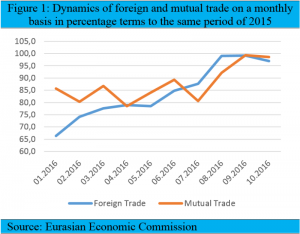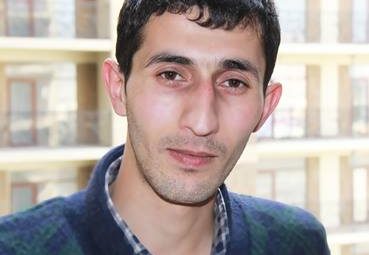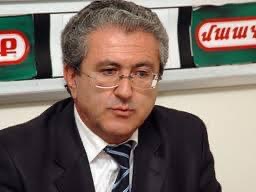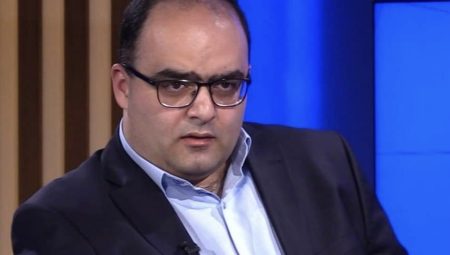The yearly meeting of the Supreme Eurasian Economic Council was held in St. Petersburg on December 26, 2016. The Presidents of Russian Federation, Kazakhstan, Kyrgyzstan and Armenia reviewed the work conducted by the Supreme Eurasian Economic Council since the creation of the union and made an overview of the main objectives to be reached 2017. This is the second meeting of the Supreme Eurasian Economic Council and Kazakhstan holds the chairmanship of the Council in 2016. Despite problems such as negative GDP growth, trade slowdown, high pressure on currencies of the member-states during 2016, the Supreme Eurasian Economic Council was able to achieve further development of the union. Since the creation of the common market with free flow of goods, labor and capital, the trade between the member-states has been significantly liberalized. The level of non-tariff barriers of trade has been reduced approximately by 30%. A common market on pharmaceuticals and medical goods started to function this year. When it comes to further integration of markets between the member-states, the leaders of the member states admitted the crucial importance of establishing of a common financial market and a common market of petroleum and gas products. The latter accounts for almost one quarter of the mutual trade within the EEU (Mkrtchyan, A. 2013). Works on harmonization and liberalization of trade in these highly important sectors are currently underway and are planned to be completed by 2025. Apart from that, works on liberalization of the electricity market, service sector and development of the common digital economy are currently in progress. Several documents that cover all these issues and some other issues of trade liberalization between the member-states were endorsed during the meeting by the heads of the states.
Although during January-October 2016 the overall real GDP of the Union fell by 0.7% growth figures for each country are different. Belarus (2.9%) and Russia (0.7%) had clearly negative GDP growth during the given period whereas Kyrgyzstan (2.9%), Armenia (0.5%) and Kazakhstan (0.4%) had small but still positive GDP growth. The overall in industrial output had a small growth of 0.1% while the agricultural sector had a moderate growth of 2.9%. Sectors that had the biggest negative growth rates are retail trade (-4.8%) and construction (-4.4%). The primary reason of the poor economic performance of the EEU during the last two years is the decline in oil prices that began in 2014. All the member states of the EEU are emerging economies that have been growing by integrating to world market (Capital Economics, 2016). In this regard, due to their high level of dependence on oil exports, Russia and Kazakhstan have suffered severely from falling oil prices. Since the Russian economy is by far the largest one in the EEU, the crisis in Russia has spread to other members of the EEU through spillover effect causing constriction in many sectors. Therefore, the economic performance of Kyrgyzstan and Armenia, which lie in the peripheries of the EEU and have less intense trade with Russia, is better than that of Belarus, which makes the core of the EEU and relies very much on Russia in its external trade. However, despite the significant decline in trade, the general pattern remains positive. Volumes of foreign trade of the EEU in August was only 0.9% less than during the same period of 2015 and the turnover of the mutual trade between the member-states in September reached 99.3% of the trade turnover of September of 2015. Dynamics of foreign and mutual trade on a monthly basis in percentage terms to the same period of 2015 is shown in Figure 1. The curves reflect the percentage difference of monthly trade volumes of 2016 to the same period of 2015.

The Council achieved a great success in trade cooperation with countries outside the union. Thus, there is a free trade agreement between the EEU and Vietnam since July 2016. Much progress was made in preparations for talks on creation of free trade zones with Iran, India, Singapore, Egypt, South Korea, Israel and China. At the end of the meeting, the heads of the EEU member states endorsed four documents on the initiating negotiations on free trade zones with Iran, India, Singapore and Egypt. The rest of the policies concerning preparations for negotiations on establishing free trade zone with South Korea and China and different forms of cooperation with countries outside the union were described in another document called “The decision on the Main Directions of the International Activity of the Eurasian Economic Union for 2017”.
Following the meeting, 25 documents were endorsed by the heads of the EEU member states. Five of these documents were about international cooperation. The rest of the documents tackle various internal issues like unification of the energy market, trade liberalization of the service market, customs policy, creation of the common financial market, formation of the budget of the economic union for 2017 etc.
However, there is an important issue that was not covered properly by the agenda of the meeting. Particularly, the leaders of the EEU approved documents on negotiations on free trade agreements with Iran, India, Singapore and Egypt. However, the agenda of the meeting did not mention anything on issues of cooperation with such close and important regional partners like Tajikistan and Uzbekistan. Although these two states have been maintaining rather limited economic relations since the beginning of the integration process, the new presidential administration of Uzbekistan accomplished drastic changes in economic relations with neighboring countries. Thus, within a short period of time the newly elected president of Uzbekistan has already signed many economic agreements with Kazakhstan, Kyrgyzstan and Tajikistan breaking long-term tension and bringing these relations into a new more friendly and cooperative format. From the point of view of the EEU, the issue of economic cooperation with Uzbekistan and Tajikistan should be considered together due mutual interdependence of these states in many areas. Tajikistan has been showing much interest in the process of Eurasian integration long since (Eurasian Daily, 2015; Avesta News, 2016; BelTA, 2016). However, its abilities to establish closer economic contacts with the EEU member-states were to certain extend hindered by previous tensions with Uzbekistan. Now has become more obvious that under the new political realm, that Uzbekistan wants to create, the economic cooperation of the EEU member-states with Uzbekistan and Tajikistan has to be tailored into a new format jointly the EEU level.
It is worth mentioning that the President of Belarus Aleksandr Lukashenko was absent in the meeting of the Supreme Eurasian Economic Council. Although the official administration of the Russian President states that this circumstance will not have any effect on the decisions taken during the meeting and that President Lukashenko had a valid excuse for his absence in the meeting, it seems at least rather confusing.
The meeting of the Supreme Eurasian Economic Council that takes place at the end of each year is highly important because it determines the general framework of the EEU and identifies the main policy principles and priorities in various issues for the following year. In general, we see that there is no blatantly conflictive views between the union partners. Despite negative economic patterns that have certain influence on the EEU, the projections for the following year are optimistic. The member-states have shown a great willingness to integrate further into the union. When it comes to cooperation with countries outside the EEU, the policy of the EEU seems rather friendly. All the EEU member-states are ready to accept any trade liberalization initiatives from any non-EEU country. Negotiations on establishing free trade zones with four countries are already under consideration. Thus, the talks on the meeting of the Supreme Eurasian Economic Council held on December 26, of 2016 can be resumed in four main objectives: (i) to achieve a positive GDP growth by the end of 2017, (ii) – to restore the mutual and foreign trade turnover to previous levels, (iii) – to liberalize further the trade between the member states and (iv) – to achieve free trade agreements with certain non-EEU countries.
References
Avesta News (2016): “Tajikistan Considering EEU Entry”, 20 July 2016.
Belarusian Telegraph Agency (2016): “Tajikistan considering membership in EEU”, October 20th, 2016.
Capital Economics (2016): “The end of the Golden Age”, Emerging Markets Economics Focus, 13 October, 2016
Eurasian Daily (2015): “Tajikistan Mulls Joining Eurasian Economic Union”, July 6th, 2015.
Eurasian Economic Commission: Statistics on foreign and mutual trade in goods
Mkrtchyan, A. (2013): “Trade impact of non-tariff trade costs. An Assessment of the Customs Union of Russia, Belarus and Kazakhstan”, Economics Education and Research Consortium, Working Paper Series No 13/14E.
Note: The views expressed in this blog are the author’s own and do not necessarily reflect the Institute’s editorial policy.
************************************************

Kanat Makhanov;
Kanat Makhanov is a research fellow at the Eurasian Institute of the International H.A Yassawi Kazakh-Turkish University. He holds a BA in Business Economics from the KIMEP University from 2012.
http://eurasian-research.org/en/research/comments/economy/meeting-supreme-eurasian-economic-council-2016





